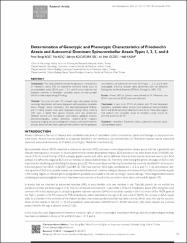| dc.contributor.author | Boz, Pınar Bengi | |
| dc.contributor.author | Koç, Filiz | |
| dc.contributor.author | Sel, Sabriye Kocatürk | |
| dc.contributor.author | Güzel, Ali İrfan | |
| dc.contributor.author | Kasap, Halil | |
| dc.date.accessioned | 2020-12-19T19:51:00Z | |
| dc.date.available | 2020-12-19T19:51:00Z | |
| dc.date.issued | 2016 | |
| dc.identifier.citation | Boz, P. B., Koç, F., Kocatürk Sel, S., Güzel, A. İ., & Kasap, H. (2016). Determination of Genotypic and Phenotypic Characteristics of Friedreich's Ataxia and Autosomal Dominant Spinocerebellar Ataxia Types 1, 2, 3, and 6. Noro psikiyatri arsivi, 53(2), 115–119. https://doi.org/10.5152/npa.2015.9925 | en_US |
| dc.identifier.issn | 1300-0667 | |
| dc.identifier.issn | 1309-4866 | |
| dc.identifier.uri | https://doi.org/10.5152/npa.2015.9925 | |
| dc.identifier.uri | https://hdl.handle.net/11436/2495 | |
| dc.description | Kocaturk Sel, Sabriye/0000-0003-2446-0979; GUZEL, Ali irfan/0000-0002-9720-5920 | en_US |
| dc.description | WOS: 000379331000005 | en_US |
| dc.description | PubMed: 28360782 | en_US |
| dc.description.abstract | Introduction: This study aimed to analyze the genotypic characteristics of Friedreich's ataxia (FA) and autosomal dominant ataxias [such as spinocerebellar ataxia (SCA) types 1, 2, 3, and 6] using molecular and biological methods in hereditary cerebellar ataxia considering both clinical and electrophysiological findings. Methods: the study included 129 indexed cases, who applied to the neurology department and were diagnosed with hereditary cerebellar ataxia through clinical, laboratory, and electrophysiological findings, and 15 sibling patients who were diagnosed through family scanning (144 cases in total); their genetic analyses were also performed. Detailed physical and neurological examinations, pedigree analyses, electroneurography, evoked potentials, cerebral-spinal magnetic resonance imaging, and echocardiographic analyses were performed for all cases. Blood samples were collected from patients, and the genotypic characteristics of autosomal dominant SCA types 1, 2, 3, and 6 were investigated. Statistical analyses were performed with the Statistical Package for the Social Sciences (SPSS Inc; Chicago, IL, USA) 17.0. Results: Almost 50% of patients were defined as FA. Moreover, two SCA1 cases and one SCA6 case were detected. Conclusion: in our study, 47.2% of patients with FA had developed hereditary cerebellar ataxia. Ground and autosomal dominant-linked SCA1 and SCA6 were each detected in one family. These data suggest that patients with cerebellar ataxia of hereditary origin should be primarily examined for FA. | en_US |
| dc.description.sponsorship | Cukurova University, Individual Research Projects Units [TF2006BAP13] | en_US |
| dc.description.sponsorship | The authors have taken support of Cukurova University, Individual Research Projects Units (Project No. TF2006BAP13) in this paper. | en_US |
| dc.language.iso | eng | en_US |
| dc.publisher | Aves | en_US |
| dc.rights | info:eu-repo/semantics/openAccess | en_US |
| dc.subject | Hereditary | en_US |
| dc.subject | Friedreich's ataxia | en_US |
| dc.subject | autosomal recessive ataxia | en_US |
| dc.subject | spinocerebellar ataxia | en_US |
| dc.title | Determination of genotypic and phenotypic characteristics of friedreich's ataxia and autosomal dominant spinocerebellar ataxia types 1, 2, 3, and 6 | en_US |
| dc.type | article | en_US |
| dc.contributor.department | RTEÜ, Tıp Fakültesi, Temel Tıp Bilimleri Bölümü | en_US |
| dc.contributor.institutionauthor | Güzel, Ali İrfan | |
| dc.identifier.doi | 10.5152/npa.2015.9925 | |
| dc.identifier.volume | 53 | en_US |
| dc.identifier.issue | 2 | en_US |
| dc.identifier.startpage | 115 | en_US |
| dc.identifier.endpage | 119 | en_US |
| dc.ri.edit | oa | en_US |
| dc.relation.journal | Noropsikiyatri Arsivi-Archives of Neuropsychiatry | en_US |
| dc.relation.publicationcategory | Makale - Uluslararası Hakemli Dergi - Kurum Öğretim Elemanı | en_US |


















